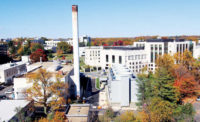When the time comes to replace a cooling tower, all too often the recommendation is to source an identical replacement; however, cooling tower technology is evolving, and some building owners are reaping the rewards by researching the benefits of the newest options.
Recently, two institutions received valuable lessons on cooling tower systems that helped them avoid selecting troublesome technologies in favor of new solutions that will aim to provide much longer service lives and operational savings. A first-hand examination of the manufacturing process for engineered plastic convinced both buyers to opt out of the repeated cycle of buying metal and instead chose cooling towers constructed out of high-density polyethylene (HDPE).
For Frostburg State University (FSU), the time came in 2017 when the institution faced the task of replacing a failing cooling tower as part of an HVAC system overhaul. The system cools one of the campus’s dining halls during warm weather. Initially, the engineering and maintenance team examined two basic options: a costly switch to a new air-cooled system or the purchase of another metal-clad cooling tower to replace the old rusted-out unit university staff continually struggled to maintain.
In search of a better option, FSU’s in-house engineering staff turned to Casto Technical Service, in Charleston, West Virginia. Paul Lancaster, contracting operations manager for the company, specializes in delivering mechanical services for commercial, institutional, and industrial building systems. He’s assisted the university on several other projects over the years.
Lancaster was quick to recognize that converting to an air-cooled system would require that the unit be installed on the roof of the cafeteria. The unit would have to be equipped with weight constraints and the piping would have to be run outside the building, which would likely be problematic in freezing weather and create an excessive hit to the budget. Additionally, air-cooled systems typically consume 40-50% more energy than water-cooled systems.
On the other hand, replacing the existing system with another metal option would have inevitably led to more exorbitant cooling tower maintenance costs.
“The university’s staff was very uneasy about replacing the cooling tower with another metal-clad unit because of the ‘built-in’ deterioration of the tower due to rust and corrosion along with high maintenance costs,” said Lancaster.
Even with the objection clearly stated, many of the service contractors bidding on the project were proposing doing just that — replacing the equipment with identical units — even in the face of frequent costly repairs and service interruptions, noted Lancaster.
Recognizing the inherent weaknesses of traditional metal cooling towers, Lancaster’s team pursued HDPE technology developed by Delta Cooling Towers. HDPE cooling towers are impervious to caustic environmental elements that continually attack metal units, ranging from marine air and airborne process exhausts to harsh gases from wastewater treatment. These engineered plastic cooling towers are unaffected by pH from water sources.
The shortcoming of metal cooling towers cited by the university’s in-house engineers were actually the strongest selling points of HDPE models, Lancaster said.
“I gave them a brochure on HDPE cooling towers and they looked it over and said they loved the idea,” said Lancaster. “As a result, we were able to proceed without a total redesign of the package; we simply did a replacement, which kept the costs much lower. And by incorporating the HDPE technology, there will be very little maintenance, so we created an optimum solution that would last for a long time to come.”
The cooling tower Casto and FSU settled on was a Delta Paragon model with 200 cooling tons.
Located in Maryland, Frostburg University is within driving distance to Delta’s Philippi, West Virginia, manufacturing and assembly plant. Lancaster and his team took a trip to the facility to see the manufacturing process of the one-piece, corrosion-proof shell.
“I’ve been in this business for 38 years, and I know a good solution when I see one,” said Lancaster. “They showed us all the steps in the manufacturing of these cooling towers and pointed out the variety of options. It was well worth the visit.”
A few months afterward, Jeff Shropshire, project manager and estimator for Brady Services in Greensboro, North Carolina, also toured the West Virginia plant. Brady provides building and HVAC solutions for commercial and industrial facilities.
Like Lancaster, Shropshire was searching for an improved cooling tower for Western Harnett High School in Lillington, North Carolina. Used in combination with source water heat pumps to warm the high school, the original metal cooling tower had been patched so often that repairs were no longer possible. In an effort to view the system’s potential, the service technicians visited a newer high school in the area that had recently installed an HDPE model that was connected to a heat exchanger.
“Some of the school system’s officials visited the Delta plant to explore all the choices available and were so impressed with the company’s HDPE technology — and the standard 20-year warranty — that this became the cooling tower of choice for the entire school system,” Shropshire said.
The new cooling tower was a “modular” TM Series model that provides approximately 600 cooling tons. While the Western Harnett High application required just two cells, the TM Series is designed to accommodate up to six modular cells with a total cooling capacity of up to 2,500 tons, making this an optimal design for institutions that may require future expansion of their HVAC or process cooling systems.
Shropshire notes that these HDPE cooling tower cells are equipped with VFDs, which will greatly reduce energy costs for years to come.




